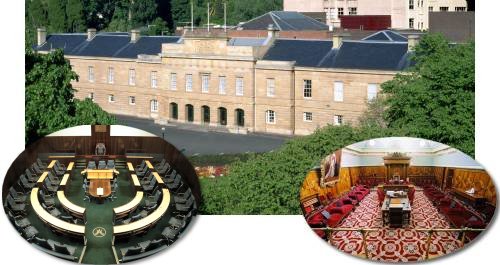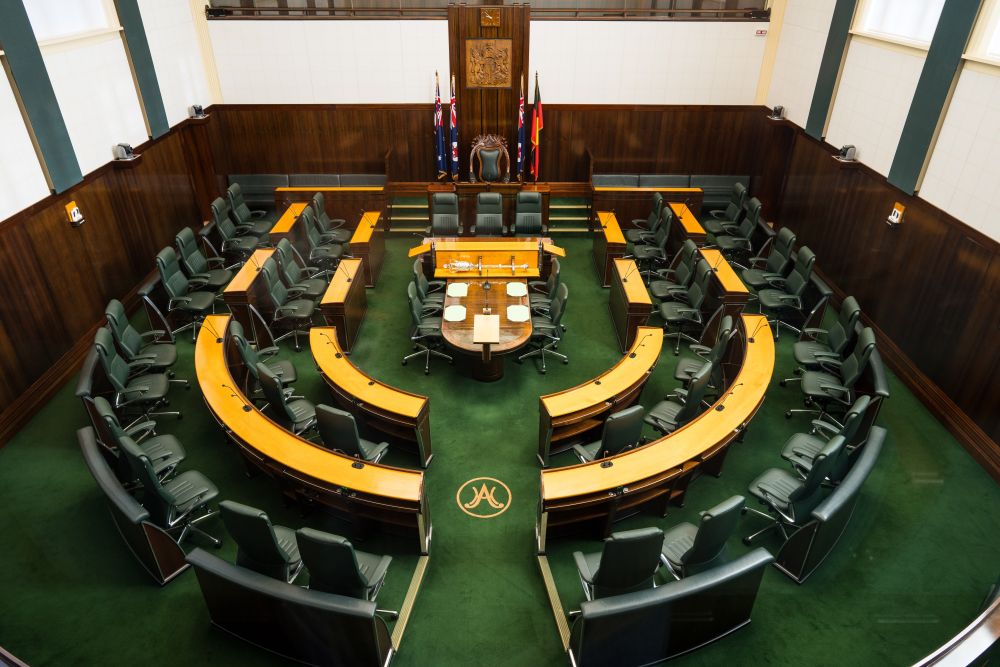Business of the House
Parliament

Parliament consists of three parts: the Crown, the Legislative Council and the House of Assembly. These three acting together make State laws for Tasmania.
It is the task of Parliament to provide a forum for the people's elected representatives to debate the important issues of the day and make laws accordingly.
The Governor has an important formal role as part of the Parliament. The Governor summons, prorogues and dissolves Parliament on the advice of the Premier. When summoning Parliament, the Governor makes a speech to all members outlining the Government's legislative program for the forthcoming session. The Governor also acts on behalf of the monarch to give the royal assent to bills passed by the House of Assembly and Legislative Council.
It is through Parliament and the free speech of its members that matters of public concern can be raised.
History
Tasmania is the second oldest Australian settlement, having been established at Risdon Cove on the River Derwent by Lieutenant John Bowen in September 1803. Shortly after Hobart's settlement, Colonel William Patterson established a settlement on the Tamar River in the north of the island at the site which subsequently became Launceston. Until 1812 the colony was divided into two counties and administered separately from Sydney. In that year Colonel Thomas Davey was appointed the first Lieutenant Governor of the whole colony.
Van Diemen's Land, as it was then known, became a colony under its own administration on 3 December 1825. The colony was administered by the Lieutenant Governor, Colonel (later Sir) George Arthur, and a Legislative Council of six members. In 1856 the name of the colony was changed to Tasmania. In the same year responsible government was established and the bicameral Parliament met for the first time. The basic constitutional structure has remained the same since that time.
The first elections for the House of Assembly were held in September and October 1856. The first ministry, with Mr. W. T. N. Champ as Premier, was sworn in on 1 November and the first Parliament opened on 2 December 1856. The House met in what is now the Members Lounge and continued to do so until 1940 when it moved into its present chamber.
The colony was divided into 24 electoral districts for the House of Assembly. Hobart returned five Members, Launceston three and the others one each, giving a total of 30 Members. The term for the House of Assembly was a maximum of five years. All voters had to be adult males, natural born or naturalised citizens and to have been resident in the colony for a minimum of 12 months.
Since 1856 there have been a number of constitutional and electoral changes, including voting qualifications, number of Members and the electoral system.
The size of the Parliament has varied as follows:
| Date | Legislative Council | House of Assembly | Total |
|---|---|---|---|
| 1856 | 15 | 30 | 45 |
| 1870 | 16 | 32 | 48 |
| 1885 | 18 | 36 | 54 |
| 1893 | 18 | 37 | 55 |
| 1898 | 19 | 38 | 57 |
| 1900 | 18 | 35 | 53 |
| 1906 | 18 | 30 | 48 |
| 1946 | 19 | 30 | 49 |
| 1959 | 19 | 35 | 54 |
| 1998 | 19 | 25 | 44 |
| 1999 | 15 | 25 | 40 |
| 2024 | 15 | 35 | 50 |
Women became eligible to vote in 1903 at the same time as universal adult suffrage was brought in for House of Assembly elections. Women first became eligible for election to Parliament in 1921, but it was not until 1948 that the first woman was elected. Payment of members began in 1891 at a rate of £100 per annum.
In 1906 the State was divided into five electoral districts for House of Assembly elections, each returning six members, making a total of 30. They were elected by the Hare-Clark system of proportional representation. From 1959 each electorate returned seven members, making the membership total 35. In 1998 the Parliamentary Reform Act reduced this number to five per electorate, a total of 25.
Vacancies are filled by continuing the cut-up of the votes of the previous election in the electorate concerned, starting with the distribution of the preferences of the former member. This method is used instead of a by-election to retain as far as possible the political make-up of the House established at the previous general election. The term of a Parliament was changed from five to three years in 1969. It was again changed in 1972 to five years for that Parliament and four years for subsequent Parliaments.
House of Assembly
In the House of Assembly the political grouping which has a majority of the members, i.e. 18 or more, forms the Government, but on several occasions in Tasmania's recent history there has been a government which has not had a majority and has formed a formal or casual coalition with members of another party or independents to form a government.
The government leader is the Premier and the size of the ministry varies but under the Constitution Act can be no more than eleven, or ten where a Secretary to Cabinet has been appointed. The largest minority party in the House is known as the Opposition and is the 'alternative government'.
The initiative for government action resides with the House of Assembly. Nearly all legislation is introduced to the Parliament in the Assembly. Appropriation, land tax and income tax bills must originate in the House of Assembly.
It is in the House of Assembly that governments are made, where their policies first take legislative shape, and where a government comes face to face with the Opposition, which will attempt to show itself to be a better choice for government by pointing out deficiencies, as it sees them, in government policies and suggesting alternative policies to those put forward by the Government. The Government has the opportunity in the House to explain its policies fully and the action it intends to take to implement them.
House of Assembly Chamber

From 1856 to 1940 the House of Assembly used as its chamber the room which is now the Members' Lounge.
During the late 1930s renovations and extensions were carried out which provided for a new chamber as well as more office accommodation and improvements to other facilities.
The present chamber was opened on 14 May 1940 by the Premier, the Honourable Robert Cosgrove MP. It was remodeled in the late 1970s, mainly to provide for better acoustics due to the impending introduction of Hansard. The chamber was further remodeled during 2008 and returned to the style of the original 1940s chamber. The modernisation included installation of television cameras, computer access, disabled access and modern facilities for members and the public. The chamber was formally opened on 26 February 2009.
Relations with the Legislative Council
The two Houses of the Tasmanian Parliament have almost equal powers.
Appropriation and taxation legislation must be introduced in the House of Assembly and the Legislative Council may either accept or reject, but not amend it.
It is a convention that the initiation of legislation resides in the House of Assembly, leaving the Legislative Council to act as a House of review.
Parliamentary Privilege
Parliamentary privilege is defined by the practice of the House of Commons and the Parliamentary Privilege Act and amendments. It relates to the rights and immunities which are necessary to allow Parliament to meet and carry out its proper constitutional role.
The principal powers relating to the application of privilege are:
The right of free speech in Parliament.
Immunity of members from legal proceedings for anything said by them in a speech in the course of debate in the House.
Immunity from arrest and imprisonment for civil causes whilst attending Parliament.
Exemption of members from jury service.
Immunity of parliamentary witnesses from being questioned or impeached for evidence given before the House or its committees.
The power to order the arrest and imprisonment of persons guilty of contempt of Parliament or breach of privilege.
The purpose of parliamentary privilege is to enable members to carry out their duties in the knowledge that certain protections exist so they may not be unduly constrained in their role as representatives of the people.
Electoral System
As mentioned above, the House of Assembly has 35 Members. There are five electorates each returning seven members. The voting system used is a form of proportional representation known as the Hare-Clark system.
Under the Hare-Clark system of proportional representation by the single transferable vote an elector is required to vote, in order of preference, for at least seven candidates. Names are arranged on the voting papers in groups according to party allegiance and names of parties are specified. The order in which the candidates' names are listed within each group is rotated in order to minimise the effect of position on voting.
In order to secure election, a candidate must receive a quota of votes (the total first preferences cast in the electorate divided by eight, plus one vote). The second preferences of the first successful candidate are transferred to other candidates after first being multiplied by a fraction called the transfer value (the candidate's surplus first preferences divided by their total first preferences). This process is repeated with the votes of other successful candidates until a position is reached where no further candidates can reach a quota. Then the candidate who is lowest on the poll is excluded and the second preferences on his or her voting papers are transferred to the remaining candidates. These procedures are repeated until seven candidates have been elected.
